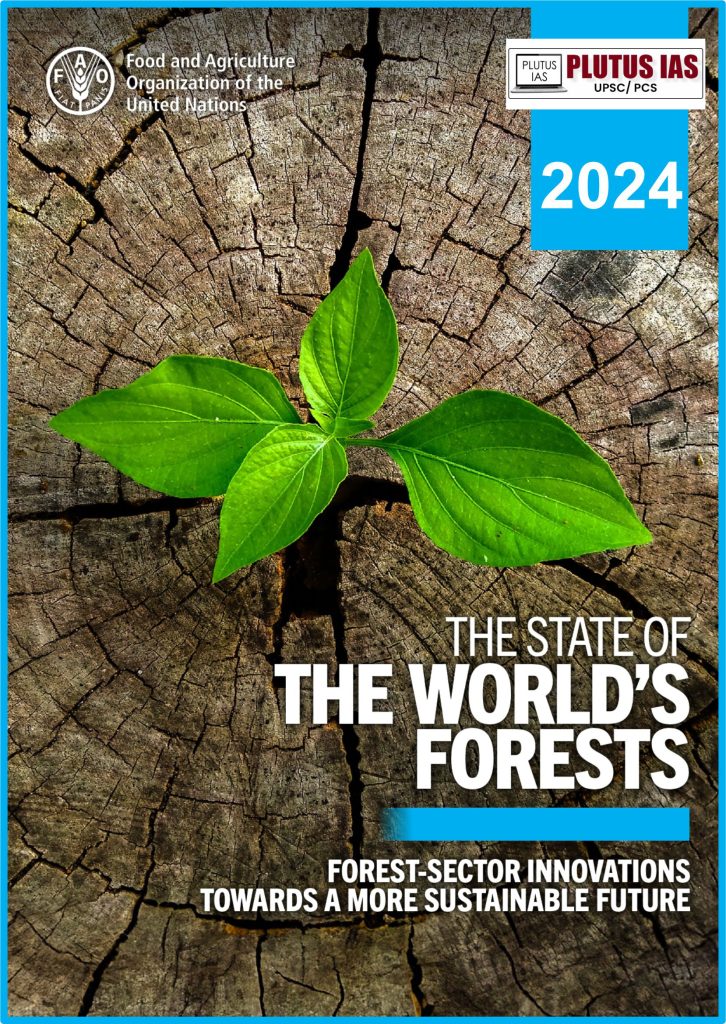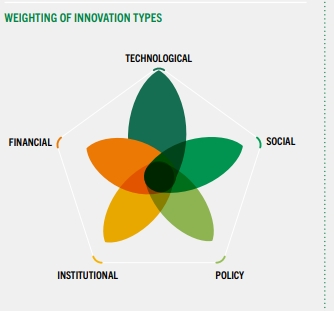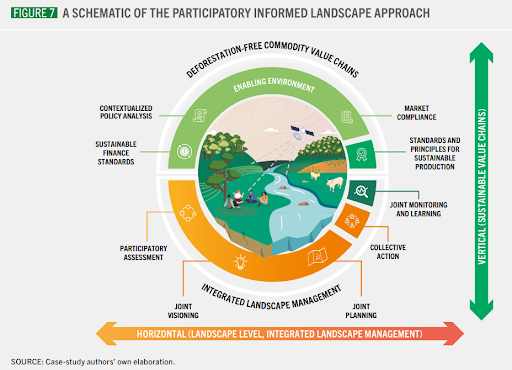25 Jul FAO: THE STATE OF THE WORLD FOREST REPORT 2024
FAO: THE STATE OF THE WORLD FOREST REPORT 2024: FOREST SECTOR INNOVATIONS TOWARD THE MORE SUSTAINABLE FUTURE.
This article covers “Daily Current Affairs,” and the topic details the recently published biannual State of the World Forest Report 2024.
Syllabus mapping: GS-3: The conservation and Protection, environmental pollution, and degradation, environmental impact assessment.
For Prelims:
What are the trends in world forests across the world and in India?
India-related data published in a report and terminology.
For Mains:
Various causes of change in forest trends, measures taken, and innovation are suggested by the report along with the case studies mentioned in the report.
Why In News
FAO’s flagship publication, The State of the World’s Forests (SOFO), published every two years, presents data and analysis on the interactions between forests and people, with a specific thematic focus.

| FAO(1945): Food and Agriculture Organization is the United Nations organization.
Headquarters: Rome, Italy. Mandate: FAO’s primary mandate is to improve global food security, promote agricultural development, and reduce hunger and malnutrition worldwide. India: India is a member. Globally Important Agricultural Heritage Systems (GIAHS): Concept promoted by FAO. Four sites in India have the above recognition: Kuttanad Below Sea Level Farming System, Kerala. Saffron Heritage of Kashmir. Koraput Traditional Agriculture, Odisha and Apatani Cultural Landscape, Arunachal Pradesh. |
KEY FINDINGS:
- Deforestation Trends: While there has been a reduction in deforestation rates in some regions (e.g., Indonesia and Brazil’s Legal Amazon), forests globally are still under pressure. The slowdown in deforestation is positive but needs sustained efforts to ensure forest conservation.
- Climate Change Impact: Forests are increasingly vulnerable to climate-related stressors such as wildfires and pests. Wildfire intensity and frequency are rising, contributing significantly to carbon dioxide emissions. Boreal forests, for example, emitted a substantial amount of CO2 due to wildfires in recent years.
- Global Wood Production: Wood production is at record levels, with approximately 4 billion cubic meters harvested annually. Wood-fuel remains a significant component, especially in Africa, where it constitutes a 90 percent proportion of total wood harvested.
- Non-Timber Forest Products: Nearly 6 billion people use non-timber forest products globally, highlighting their socio-economic importance, particularly for rural communities in the Global South. International trade in products like pine nuts forest mushrooms and truffles is substantial.
- Future Demand and Innovation: Projections indicate a potentially significant increase in wood demand by 2050, driven by industrial needs. Innovations in forest management, bio-economy transitions, and sustainable practices are crucial to meet these demands while conserving and restoring forests.
- Need for Innovation: Innovation is seen as essential for scaling up forest conservation, restoration, and sustainable use as solutions to global challenges. It is crucial for adapting to climate change impacts, transitioning to a bio-economy, and harnessing the potential of non-wood forest products.
FAO Global Forest Resources Assessment 2020, here are the top ten countries ranked by average annual net gain in forest area from 2010 to 2020:
- China: 1,937 thousand hectares per year
- Australia: 446 thousand hectares per year
- India: 266 thousand hectares per year
- Chile: 149 thousand hectares per year
- Viet Nam: 126 thousand hectares per year
- Turkey: 114 thousand hectares per year
- United States of America: 108 thousand hectares per year
- France: 83 thousand hectares per year
- Italy: 54 thousand hectares per year
- Romania: 41 thousand hectares per year
How different types of innovation are enhancing the potential of forests and trees to address global challenges:
- Technological Innovation: Utilization of remote-sensing data and cloud computing to improve forest data quality and management processes. Introduction of new tools and techniques in forest management and community forestry.
- Social Innovation: Efforts to engage marginalized groups like women, youth, and Indigenous Peoples in developing locally-led solutions. Promotion of multi-stakeholder partnerships and cross-sectoral approaches in land-use policies and planning. Support for cooperatives to enhance the bargaining power of smallholders in forest management.
- Policy Innovation: Development of new policies that support agroforestry and sustainable landscape management. Adoption of governance models that scale up integrated sustainable practices in forest conservation across different regions.
- Institutional Innovation: Establishment of new institutions or adaptation of existing ones to better address the challenges of forest conservation and restoration. Integration of innovative approaches into existing institutional frameworks to enhance effectiveness and sustainability.
- Financial Innovation: Innovations in public and private-sector finance to increase the value of standing forests. Boosting restoration efforts through financial mechanisms that support sustainable production and conservation.
Barriers to Scaling Up Innovation:
The lack of innovation culture is due to the lack of the following type of capital:
- Human capital: Lack of skills, knowledge, and experience; wariness of “new” innovations; uncertainty about the potential for unintended impacts arising from innovation adoption
- Natural capital: Limited access to forests, land, and natural resources and their assets and products
- Physical capital: Lack of infrastructure such as roads, markets, electrical power, and internet; lack of resourcing to “scale down” and adapt innovations to suit the contextual needs of diverse stakeholders from the bottom up
- Financial capital Limited access to financial capital, credit, and value chains
- Social capital Restrictive governance and tenure rights for forests, land resources, and their assets and products; limited access to information; lack of transparency; limited participation in decision-making sectors.
- Risk: Innovation is inherently risky because a significant \portion of innovations – perhaps even 95 percent do not meet the expectations of stakeholders.
- Capital Limitations: Ensuring adequate funding and resources to support innovative initiatives.
- Unsupportive Policies and Regulations: Reforming policies and regulations that hinder innovative practices in the forest sector.
Five enabling actions will help scale up responsible and inclusive – and essential innovation in the forest sector:
(1) Raise awareness
(2) Boost innovation skills, capabilities, and knowledge
(3) Encourage transformational partnerships
(4) Ensure more and universally accessible finance for innovation.
(5) Provide an incentivizing policy and regulatory environment

PARTICIPATORY APPROACH:
Case Studies:
- Forest Conservation: Examples include multi-stakeholder governance models in Kenya and Nigeria and technological innovations in Ghana to reduce commodity-driven forest loss.
- Restoration: Innovations like new national policies supporting agroforestry in India and socioeconomic integration in reforestation efforts. use of new data on the role of forests in agricultural productivity to finance forest conservation in Brazil;
- Sustainable Use: Case studies focusing on combining science, technology, and traditional knowledge to support Indigenous Peoples as custodians of forests and the introduction of new tools and techniques in community forestry in Colombia.
- PAPUA NEW GUINEA Innovating tradition to protect ancient forests with the AIM4Forests program. Technological innovation has vastly improved our ability to monitor the world’s forests.
- PHILIPPINES: Planting mangroves increases the resilience of coastal communities
Prelims question:
Q. Which of the following is the correct description of the “Bioeconomy”?
(a) An economic system that aims to improve human well-being and social equity, while significantly reducing environmental risks and ecological scarcities. In essence, it seeks to foster economic growth and development while ensuring that natural assets are conserved and enhanced for future generations.
(b) An economic system that focuses on the production, use conservation, and regeneration of biological resources, including related knowledge, science, technology, and innovation, to provide sustainable solutions within and across all economic sectors and enable a transformation to a sustainable economy.
(c) An economic system that studies and analyzes the economic effects of geographical factors, geopolitical relationships, and international power dynamics. It focuses on how these factors shape economic policies, trade patterns, resource allocation, and global economic outcomes.
(d) It means the sustainable use of ocean resources for economic growth, improved livelihoods, and ocean ecosystem health. It emphasizes the integration of economic development with ocean conservation and sustainable management practices.
Answer: c
Mains Question:
The State of the World Forest Report underlined the significance of the innovation to tackle the impact of climate change on forest resources. In this light how different types of innovation are enhancing the potential of forests and trees to address climate and its impacts ?
(250 words,15 marks)




No Comments